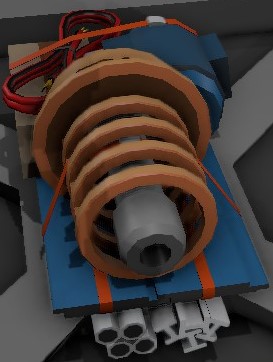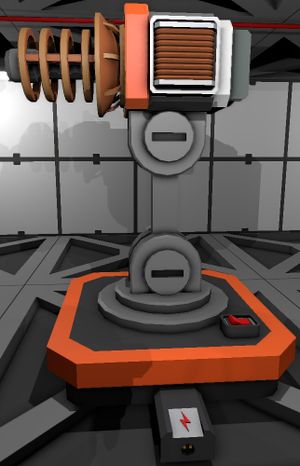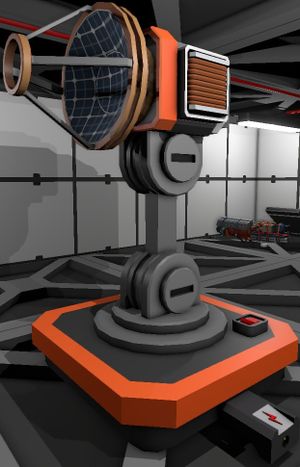Difference between revisions of "PowerTransmitter"
From Unofficial Stationeers Wiki
(made math formuals less confusing, added an IC10 script based on the math) |
m |
||
| Line 48: | Line 48: | ||
*The coordinates of these devices will change slightly when the head moves. | *The coordinates of these devices will change slightly when the head moves. | ||
*Both structures and terrain will block the beam. Once a beam is formed it will no longer be blocked by building things between them. | *Both structures and terrain will block the beam. Once a beam is formed it will no longer be blocked by building things between them. | ||
| − | *When these devices are built their placement rotation is important. | + | *When these devices are built their placement rotation is important. By pointing the data-port to the north (0°), the devices initial horizontal rotation is also 0°, which makes the math a little easier. |
| − | *When the head | + | *When the device head is rotated horizontally they are moving in the opposite of the expected direction, this flipped behaviour must be compensated for. |
| Line 76: | Line 76: | ||
<br>Vertical for "reciever" = 180 - Vertical for "emitter" | <br>Vertical for "reciever" = 180 - Vertical for "emitter" | ||
| + | Comments: | ||
| + | <br>When the data-port points north, +0° is added to the Horizontal rotation. | ||
| + | <br>When the Vertical rotation is 90° the device head points towards the horizon, this matters because when delta-y is 0 then atan() is 0 | ||
| + | <br>Both atan2() and atan() uses radians for the angle, radians are converted to degrees by multiplying with 180/pi | ||
| + | <br>atan2(x/z) is usually written as z/x, this inversion is made to compensate for the devices inverted rotation direction | ||
| + | <br>atan(y/x) uses Pythagoras theorem to calculate x as the horizontal-plane hypothenuse of delta-x and delta-z | ||
==IC script== | ==IC script== | ||
Revision as of 04:35, 5 August 2022
| Properties | |
|---|---|
| Stacks | Yes (10) |
| Recipe | |
| Created With | Electronics Printer |
| Cost | 5 Gold, 7 Copper, 3 Steel |
| Operation | |
|---|---|
| Power Usage | 10W |
| Construction | |
| Placed with | Kit (PowerTransmitter) |
| Placed on | Large Grid |
| Stage 1 | |
| Deconstruction | |
| Deconstructed with | Hand Drill |
| Item received | 3x Electronic Parts |
| Stage 2 | |
| Deconstruction | |
| Deconstructed with | Hand Drill |
| Item received | 2x Iron Sheets |
| Stage 3 | |
| Deconstruction | |
| Deconstructed with | Hand Drill |
| Item received | Kit (PowerTransmitter) |
| Operation | |
|---|---|
| Power Usage | 10W |
| Construction | |
| Placed with | Kit (PowerTransmitter) |
| Placed on | Large Grid |
| Stage 1 | |
| Deconstruction | |
| Deconstructed with | Hand Drill |
| Item received | 1x Electronic Parts |
| Stage 2 | |
| Deconstruction | |
| Deconstructed with | Hand Drill |
| Item received | 2x Iron Sheets |
| Stage 3 | |
| Deconstruction | |
| Deconstructed with | Hand Drill |
| Item received | Kit (PowerTransmitter) |
Contents
Description
The Norsec Wireless Power Transmitter is an uni-directional, A-to B, far field microwave electical transmission system. The rotatable base transmitter delivers a narrow, non-lethal Microwave beam to a dedicated base receiver.
The transmitter must be aligned to the base station in order to transmit any power. The brightness of the transmitter's collimator arc provides an indication of transmission intensity. Note that there is an attrition over longer ranges, so the unit requrires more power over greater distances to deliver the same output.
General behaviour
- 5kW is the maximum PowerPotential that can be transmitted, this amount is reduced by distance.
- Unaffected by storms.
- Using two emitters on the same reciever doesn't appear to work
- A Logic Transmitter can mirror recievers, but not emitters.
- The coordinates of these devices will change slightly when the head moves.
- Both structures and terrain will block the beam. Once a beam is formed it will no longer be blocked by building things between them.
- When these devices are built their placement rotation is important. By pointing the data-port to the north (0°), the devices initial horizontal rotation is also 0°, which makes the math a little easier.
- When the device head is rotated horizontally they are moving in the opposite of the expected direction, this flipped behaviour must be compensated for.
Range
Power transfer with 4000 W PowerPotential
98m = 3630 W (-0.37kW)
198m = 2863 W (-1.14kW)
300m = 1409 W (-2.59kW)
400m = 0 W
Power transfer with 5000 W PowerPotential
98m = 4630 W (-0.37kW)
198m = 3863 W (-1.14kW)
300m = 2409 W (-2.59kW)
400m = 651 W (-4.35kW)
Alignment formulas
All dataports points north, the delta values are calculated from: "reciever coordinate" - "emitter coordinate"
Horizontal for "emitter" = atan2( delta-x / delta-z ) * 180 / pi
Vertical for "emitter" = 90 + atan( delta-y / sqrt( (delta-z)^2 + (delta-x)^2 ) ) * 180 / pi
Horizontal for "reciever" = 180 + Horizontal for "emitter"
Vertical for "reciever" = 180 - Vertical for "emitter"
Comments:
When the data-port points north, +0° is added to the Horizontal rotation.
When the Vertical rotation is 90° the device head points towards the horizon, this matters because when delta-y is 0 then atan() is 0
Both atan2() and atan() uses radians for the angle, radians are converted to degrees by multiplying with 180/pi
atan2(x/z) is usually written as z/x, this inversion is made to compensate for the devices inverted rotation direction
atan(y/x) uses Pythagoras theorem to calculate x as the horizontal-plane hypothenuse of delta-x and delta-z
IC script
##POWER TRANSMITTER ALIGNMENT## #When the alignment is complete, this IC housing.. #..and the Logic Transmitter can be unpowered #Transmitter/Reciever data-ports must point NORTH #transmitter = Microwave Power Transmitter alias transmitter d0 #reciever = Logic Transmitter linked to the.. #..Microwave Power Reciever alias reciever d1 alias deltaX r13 alias deltaZ r14 alias deltaY r15 define pi 3.1415 main: yield #calculate delta values l r0 reciever PositionX l r1 transmitter PositionX sub deltaX r0 r1 l r0 reciever PositionZ l r1 transmitter PositionZ sub deltaZ r0 r1 l r0 reciever PositionY l r1 transmitter PositionY sub deltaY r0 r1 #Horizontal for "transmitter" #atan2(deltaX/deltaZ)*180/pi atan2 r0 deltaX deltaZ mul r0 r0 180 div r0 r0 pi s transmitter Horizontal r0 #Horizontal for "reciever" #180 + Horizontal for "emitter" add r0 180 r0 s reciever Horizontal r0 #Vertical for "transmitter" #atan(deltaY/sqrt(deltaX^2+deltaZ^2))*180/pi+90 mul r0 deltaX deltaX mul r1 deltaZ deltaZ add r0 r0 r1 sqrt r0 r0 div r0 deltaY r0 atan r0 r0 mul r0 r0 180 div r0 r0 pi add r0 r0 90 s transmitter Vertical r0 #Vertical for "reciever" #180 - Vertical for "transmitter" sub r0 180 r0 s reciever Vertical r0 j main



